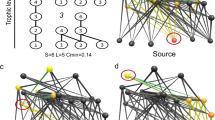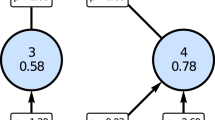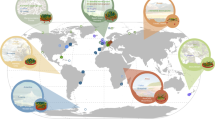Abstract
Untangling the influence of human activities on food-web stability and persistence is complex given the large numbers of species and overwhelming number of interactions within ecosystems. Although biodiversity has been associated with stability, the actual structures and processes that confer stability to diverse food webs remain largely unknown. Here we show that real food webs are structured such that top predators act as couplers of distinct energy channels that differ in both productivity and turnover rate. Our theoretical analysis shows that coupled fast and slow channels convey both local and non-local stability to food webs. Alarmingly, the same human actions that have been implicated in the loss of biodiversity also directly erode the very structures and processes that we show to confer stability on food webs.
This is a preview of subscription content, access via your institution
Access options
Subscribe to this journal
Receive 51 print issues and online access
$199.00 per year
only $3.90 per issue
Buy this article
- Purchase on Springer Link
- Instant access to full article PDF
Prices may be subject to local taxes which are calculated during checkout



Similar content being viewed by others
References
May, R. M. Stability in multi-species community models. Math. Biosci. 12, 59–79 (1971)
May, R. M. Stability and complexity in model ecosystems (Princeton Univ. Press, Princeton, 1973)
Yodzis, P. The stability of real ecosystems. Nature 289, 674–676 (1981)
de Ruiter, P. C., Neutel, A. M. & Moore, J. C. Energetics, patterns of interaction strengths, and stability in real ecosystems. Science 269, 1257–1260 (1995)
Neutel, A. M., Heesterbeek, J. A. P. & de Ruiter, P. C. Stability in real food webs: weak links in long loops. Science 296, 1120–1123 (2002)
McCann, K. S., Hastings, A. & Huxel, G. R. Weak trophic interactions and the balance of nature. Nature 395, 794–798 (1998)
Krause, A. E., Frank, K. A., Mason, D. M., Ulanowicz, R. E. & Taylor, W. W. Compartments revealed in food web structure. Nature 426, 282–285 (2003)
Pimm, S. L. The structure of food webs. Theor. Popul. Biol. 16, 144–158 (1979)
Pimm, S. L. & Lawton, J. H. Are food webs compartmented? J. Anim. Ecol. 49, 879–898 (1980)
Ives, A. R. & Hughes, J. B. General relationships between species diversity and stability in competitive systems. Am. Nat. 159, 388–395 (2002)
Post, D. M., Conners, M. E. & Goldberg, D. S. Prey preference by a top predator and the stability of linked food chains. Ecology 81, 8–14 (2000)
Teng, J. & McCann, K. S. Dynamics of compartmented and reticulate food webs. Am. Nat. 164, 86–100 (2004)
Polis, G. A. & Strong, D. Food web complexity and community dynamics. Am. Nat. 147, 813–846 (1996)
Polis, G. A. & Holt, R. D. Intraguild predation: the dynamics of complex trophic interactions. Trends Ecol. Evol. 7, 151–155 (1992)
Paine, R. T. Food-web analysis through field measurement of per capita interaction strength. Nature 355, 73–75 (1992)
Wootton, J. T. Estimates and test of per capita interaction strength: diet, abundance, and impact of intertidally foraging birds. Ecol. Monogr. 67, 45–64 (1997)
Goldwasser, L. & Roughgarden, J. Construction and analysis of a large Caribbean food web. Ecology 74, 1216–1233 (1993)
Rafaeli, D. G. & Hall, S. J. in Food Webs: Integration of Patterns & Dynamics (eds Polis, G. A. & Winemiller, K. O.) 185–191 (Chapman & Hall, New York, 1996)
Winemiller, K. O. Spatial and temporal variation in tropical fish trophic networks. Ecol. Monogr. 60, 331–367 (1990)
Polis, G. A. Complex trophic interactions in deserts: an empirical critique of food web theory. Am. Nat. 138, 123–155 (1991)
Moore, J. C. & Hunt, H. W. Resource compartmentation and the stability of real ecosystems. Nature 333, 261–263 (1988)
Moore, J. C., Walter, D. W. & Hunt, H. W. Habitat compartmentation and environmental correlates to food chain length. Science 243, 238–240 (1989)
Moore, J. C., de Ruiter, P. C. & Hunt, H. W. The influence of ecosystem productivity on food web stability. Science 261, 906–908 (1993)
Cohen, J. E. Food Webs and Niche Space (Princeton Univ. Press, Princeton, 1978)
Ulanowicz, R. E. & Baird, D. Nutrient controls on ecosystem dynamics: the Chesapeake mesohaline community. J. Mar. Syst. 19, 159–172 (1999)
Baird, D. & Ulanowicz, R. E. The seasonal dynamics of the Chesapeake Bay ecosystem. Ecol. Monogr. 59, 329–364 (1989)
Neira, S. & Arancibia, H. Trophic interactions and community structure in the upwelling system off Central Chile (33–39 degrees S). J. Exp. Mar. Biol. Ecol. 312, 349–366 (2004)
Sanchez, F. & Olaso, I. Effects of fisheries on the Cantabrian Sea shelf ecosystem. Ecol. Model. 172, 151–174 (2004)
Trites, A. W., Livingston, P. A., Vasconcellos, M. C., Mackinson, S., Springer, A. M. & Pauly, D. Ecosystem change and the decline of marine mammals in the Eastern Bering Sea: testing the ecosystem shift and commercial whaling hypotheses. Fisheries Centre Research Reports 7(1) (1999)
Hunt, H. W. et al. The detrital food web in a shortgrass prairie. Biol. Fertil. Soils 3, 57–68 (1987)
de Ruiter, P. C., Neutel, A. & Moore, J. C. Energetics, patterns of interaction strengths, and stability in real ecosystems. Science 269, 1257–1260 (1995)
Doles, J. A Survey of Soil Biota in the Arctic Tundra and their Role in Mediating Terrestrial Nutrient Cycling. Masters thesis, Univ. of Northern Colorado (2000)
Berg, M. P. Decomposition, Nutrient Flow and Food Web Dynamics in a Stratified Pine Forest Soil. Doctoral thesis, Vrije Universiteit, Amsterdam (1987)
Vander Zanden, M. J. & Vadeboncoeur, Y. Fishes as integrators of benthic and pelagic food chains in lakes. Ecology 83, 2152–2161 (2002)
McCann, K. S. The diversity–stability debate. Nature 405, 228–233 (2000)
Tilman, D. The ecological consequences of changes in biodiversity: a search for general principles. Ecology 5, 1455–1474 (1999)
MacArthur, R. H. Fluctuations of animal populations and a measure of community stability. Ecology 36, 533–536 (1955)
McCann, K. S., Rasmussen, J. B. & Umbanhowar, J. The dynamics of spatially coupled food webs. Ecol. Lett. 8, 513–523 (2005)
Holt, R. D. Optimal foraging and the form of the predator isocline. Am. Nat. 122, 521–541 (1983)
Křivan, V. Optimal foraging and predator–prey dynamics. Theor. Popul. Biol. 49, 265–290 (1996)
Terborgh, J. et al. Ecological meltdown in predator-free forest fragments. Science 294, 1923–1925 (2001)
Scheffer, M., Carpenter, S., Foley, J. A., Folke, C. & Walker, B. Catastrophic shifts in ecosystems. Nature 413, 591–596 (2001)
Acknowledgements
We thank A. de Bruyn and J. Rasmussen for helpful comments. This work was supported by an NSERC grant to K.M., and by grants from the US National Science Foundation and the National Center for Ecological Analysis and Synthesis to J.C.M.
Author information
Authors and Affiliations
Corresponding author
Ethics declarations
Competing interests
Reprints and permissions information is available at npg.nature.com/reprintsandpermissions. The authors declare no competing financial interests.
Supplementary information
Supplementary Figures
Supplementary Figure 1a details aquatic food webs, following Figure 1. Supplementary Figure 1b details terrestrial food webs, following Figure 1. Supplementary Figure 2 details theoretical food web configuration and equations. (PDF 477 kb)
Supplementary Tables
Supplementary Table 1 details production and biomass values for aquatic and terrestrial food webs after Table 1. Supplementary Table 2 details parameter definitions and values for the theoretical model. Supplementary Table 3 details real food web examples of human activities eroding food web structures. Supplementary Table 4a details taxon identification by number for Figure 1a and Supplementary Figure 1a. Supplementary Table 4b details taxon identification by number for Figure 1b and Supplementary Figure 1b. (PDF 579 kb)
Supplementary Methods
Protocol for the calculation of trophic position and percent basal resource for all food webs (PDF 56 kb)
Supplementary Notes
Full references for citations in Supplementary Table 3 (PDF 133 kb)
Rights and permissions
About this article
Cite this article
Rooney, N., McCann, K., Gellner, G. et al. Structural asymmetry and the stability of diverse food webs. Nature 442, 265–269 (2006). https://doi.org/10.1038/nature04887
Received:
Accepted:
Issue Date:
DOI: https://doi.org/10.1038/nature04887
This article is cited by
-
Predator mass mortality events restructure food webs through trophic decoupling
Nature (2024)
-
Seasonal variation in activity and nearshore habitat use of Lake Trout in a subarctic lake
Movement Ecology (2023)
-
Dynamics of species-rich predator–prey networks and seasonal alternations of core species
Nature Ecology & Evolution (2023)
-
Warming indirectly simplifies food webs through effects on apex predators
Nature Ecology & Evolution (2023)
-
Energy flow analysis of grass carp pond system based on Ecopath model
Environmental Science and Pollution Research (2023)
Comments
By submitting a comment you agree to abide by our Terms and Community Guidelines. If you find something abusive or that does not comply with our terms or guidelines please flag it as inappropriate.



